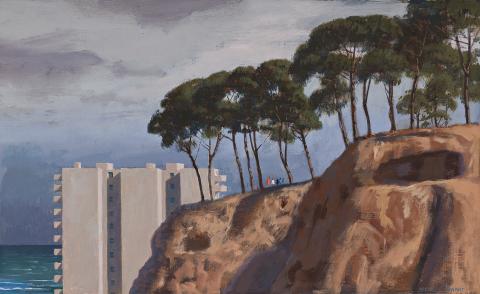First Oil Study for RING – A – ROSY, 1986
JEFFREY SMART
oil on canvas
32.5 x 52.0 cm
signed lower right: JEFFREY SMART
Australian Galleries, Melbourne (label attached verso)
Private collection, Tasmania
Creating a visual tension between the urban landscape and the natural environment, Jeffrey Smart illustrates the strength of modernity through the depiction of highways, road signs and imposing concrete buildings. The elevation of prosaic objects and structures into significant forms that attract and delight the eye is Smart's forte, as demonstrated in First Oil Study for Ring – a – Rosy, 1986. Against a brooding sky, a copse of pine trees line steep cliff faces that capture and reflect the sunlight. An apartment building – a beacon of urbanisation and a symbol of banal beauty – sits soberly in the background, demonstrating no sign of life within. The only suggestion of life is the small group of figures engaged in a lively game of Ring-a-Ring o’ Roses under the pine trees.
The human figure is an important device throughout Smart's oeuvre, providing scale and perspective against the background. Many of his figures are kept at a distance and estranged from the viewer, sometimes their backs are turned towards us or perhaps their eyes are closed, creating a divide that we cannot breach as demonstrated in First Oil Study for Ring – a – Rosy, 1986. In the picture on offer, the features of the figures are imperceptible, reduced to small dabs of colour. Their disconnection to the viewer intensifies the isolating overtones, epitomised by the characteristic Smart figures, as they are ‘invariably, emotionally remote, distanced and wholly unengaged with either their surrounds or us, the viewer.’1 And yet, despite their insignificant size against the natural and urban landscape, the bright figures are full of movement and joie de vivre as they are captured mid-dance. The affable connection between the dancers is a rare feature in Smart’s oeuvre, as often his figures are detached from each other or forced into a disturbing relationship, between a voyeur and an exhibitionist.2 In First Oil Study for Ring – a – Rosy, 1986, a rare dynamic is presented as the figures are embracing in a ‘truly mutual way’,3 reflecting the bliss and wonder of childhood games.
This subject has also been favoured by other Australian artists, including Tom Roberts. His etching of Ring O’Roses, c.1895 was followed by a similar subject in his sweeping panorama Australian Pastoral, 1904-05 in the collection of the National Gallery of Australia, Canberra. His subject, viewed from Cremorne Point, features a prominent circular group of figures dancing gracefully beside a grove of trees.
There is something idyllic about First Oil Study for Ring – a – Rosy, 1986 through the carefree exuberance of the dancers. However, the tones of the ominous sky and the dark ocean, combined with the thoughtfully structured composition and the theatrical interplay of light and dark, create an eerie stillness as the picture is expectant with premonition. Such mechanisms have cemented Smart's position as one of Australia's most significant modern artists; as Edmund Capon suggests, there is only one Jeffrey Smart, 'He emulates nobody, and nobody emulates him – at least with any degree of authenticity.'4
1. Capon, E., Jeffrey Smart Retrospective, Art Gallery of New South Wales, Sydney, 1999, p. 17
2. Allen, C., Jeffrey Smart: Unpublished Paintings 1940 – 2007, Australian Galleries, Melbourne, 2008, p. 40
3. Ibid., p. 42
4. Capon, E., op. cit., p. 12
CASSI YOUNG
